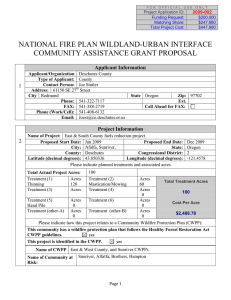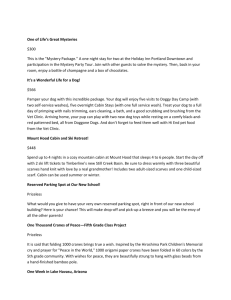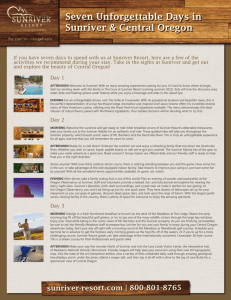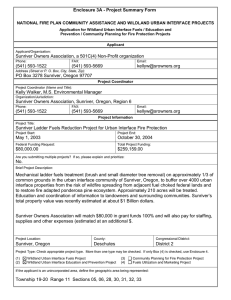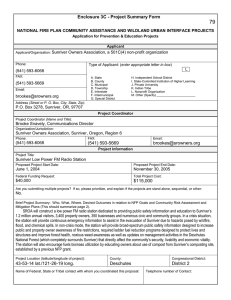Enclosure 3A - Project Summary Form
advertisement
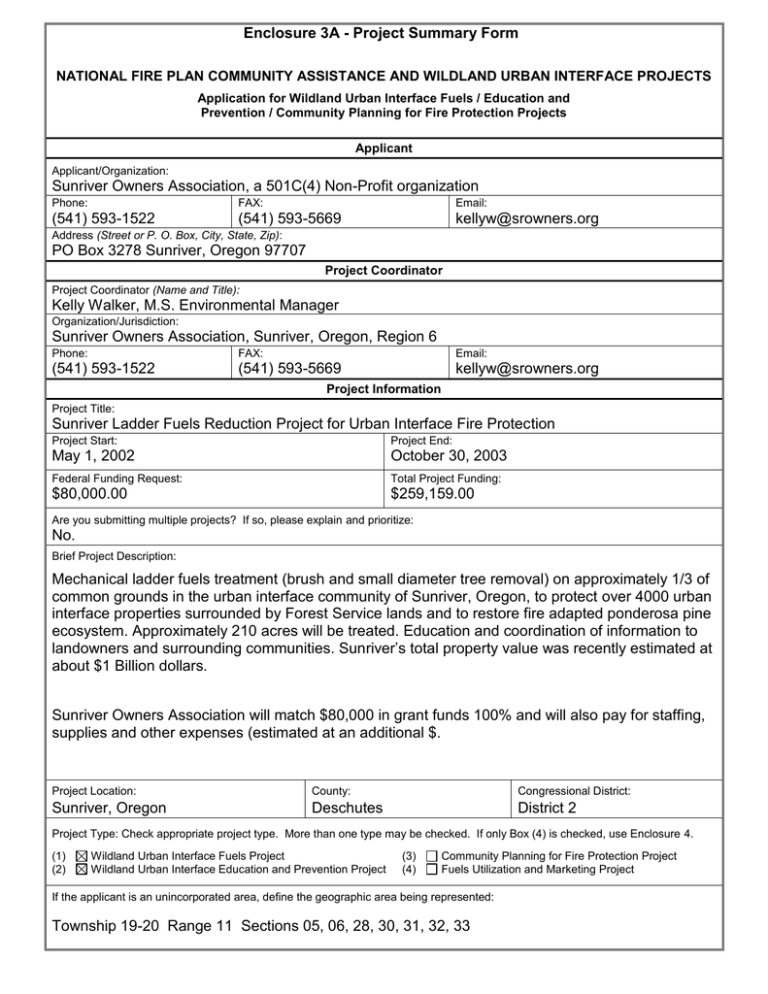
Enclosure 3A - Project Summary Form NATIONAL FIRE PLAN COMMUNITY ASSISTANCE AND WILDLAND URBAN INTERFACE PROJECTS Application for Wildland Urban Interface Fuels / Education and Prevention / Community Planning for Fire Protection Projects Applicant Applicant/Organization: Sunriver Owners Association, a 501C(4) Non-Profit organization Phone: FAX: Email: (541) 593-1522 (541) 593-5669 kellyw@srowners.org Address (Street or P. O. Box, City, State, Zip): PO Box 3278 Sunriver, Oregon 97707 Project Coordinator Project Coordinator (Name and Title): Kelly Walker, M.S. Environmental Manager Organization/Jurisdiction: Sunriver Owners Association, Sunriver, Oregon, Region 6 Phone: FAX: Email: (541) 593-1522 (541) 593-5669 kellyw@srowners.org Project Information Project Title: Sunriver Ladder Fuels Reduction Project for Urban Interface Fire Protection Project Start: Project End: May 1, 2002 October 30, 2003 Federal Funding Request: Total Project Funding: $80,000.00 $259,159.00 Are you submitting multiple projects? If so, please explain and prioritize: No. Brief Project Description: Mechanical ladder fuels treatment (brush and small diameter tree removal) on approximately 1/3 of common grounds in the urban interface community of Sunriver, Oregon, to protect over 4000 urban interface properties surrounded by Forest Service lands and to restore fire adapted ponderosa pine ecosystem. Approximately 210 acres will be treated. Education and coordination of information to landowners and surrounding communities. Sunriver’s total property value was recently estimated at about $1 Billion dollars. Sunriver Owners Association will match $80,000 in grant funds 100% and will also pay for staffing, supplies and other expenses (estimated at an additional $. Project Location: County: Congressional District: Sunriver, Oregon Deschutes District 2 Project Type: Check appropriate project type. More than one type may be checked. If only Box (4) is checked, use Enclosure 4. (1) (2) Wildland Urban Interface Fuels Project Wildland Urban Interface Education and Prevention Project (3) (4) Community Planning for Fire Protection Project Fuels Utilization and Marketing Project If the applicant is an unincorporated area, define the geographic area being represented: Township 19-20 Range 11 Sections 05, 06, 28, 30, 31, 32, 33 Enclosure 3B (Page 1 of 3) - Project Narrative Description Applications for funding must include a narrative response that describes the proposal. Please do not submit responses longer than one page, single space, 12-pitch font. Describe project including, but not limited to: project location Address these project implementation items as anticipated outcomes applicable: measures and reporting partners project income project time frames specify types of activities and equipment used amount or extent of actions (acres, number of homes, etc) environmental, cultural and historical resource requirements Response: Project location: Urban interface community of Sunriver. Approximately 3,373 acres in Central Oregon, southern Deschutes County, surrounded by Deschutes Forest lands. Project implementation: The Sunriver Owners Association will oversee implementation of the project. Anticipated outcomes: By reducing ladder fuels in Sunriver, we anticipate making our community more fire safe and protecting homes and lives. With the treatment of over 210 acres, 4000 homes and businesses, valued at US $1 billion will be protected. Measures and reporting: Mapping, photographs and “before and after” tours can be conducted. Press releases and articles will be published in the local media, focusing on the positive impacts of the National Fire Plan. Media includes local TV stations, the Sunriver Scene newspaper and the Bend Bulletin. A final report with photos and media clippings can be submitted at the end of the project. Partners: Sunriver Owners Association, Sunriver Fire Department, Sunriver Nature Center, Sunriver Resort, Sunriver Utilities, USFS, Oregon Department of Forestry, local tree service contractors. Project income: The financial benefit will be VERY positive. Increased fire safety will help augment local tourism, the foundation of Sunriver's economy, and will increase the value of local properties compated to adjacent private lands that remain at risk of catastrophic wildfires. Project timeframes: Two-year project to conduct ladder fuels reduction on 1/3 of Sunriver, about 210 acres. Specify types of activities and equipment used: Tree removal with chainsaws and climbing gear. Brush removal with rotary cutters. Limbing with saws and pole saws. Chipping materials with mechanical chippers. Removal of chips and debris to by truck to Sunriver composting site (made possible by 2001 National Fire Plan Grant to Deschutes Soil & Water Conservation District) to help supply them with a carbon source. Amount or extent of actions (acres, number of homes, etc.): Approximately 210 acres of “common ground” to be treated, providing a fire safety zone for over 4,000 residences. Environmental, cultural and historical resource requirements: Archealogical surveys of Sunriver have already been accomplished, and there will be no known cultural or historic requirements. Environmental requirements may include EIS and consideration of “Wild and Scenic River” provisions in some areas. Oregon State Forest Practices Act standards will be complied with. If SROA is selected for funding under this grant, a land agency team of specialists will work with the SROA to provide a Categorical Exclusion (CE) with the provision that SROA will mitigate any adverse environmental effects of the treatments. SROA maintains a restoration budget and will be able to comply with any needed mitigation requirements. Enclosure 3B (Page 2 of 3) - Project Evaluation Criteria Applications for funding must include narrative responses that address the following four criteria. Within each criterion, subcriteria are listed in descending order of importance. Limit your responses to the areas provided. 1. Reducing Fire Risk. (40 points)) A. Describe how the proposal promotes reduction of risk in high hazard areas or communities. B. Describe how the proposed project benefits resources on federal land or adjacent non-federal land, or how it protects the safety of communities. C. To what extent does the project implement or create a cooperative fuels treatment plan or community fire strategy (include evidence of the plan if it already exists)? D. Explain to what extent the affected community or proponent has been involved or plans to involve the affected community in a qualified fuels education program (e.g., FIREWISE). E. Explain how the proposal (a) leads to, enhances or restores a local fire-adapted ecosystem, and/or (b) mitigates or leads to the mitigation of hazardous fuel conditions. F. How will the proposed treatments be maintained over time? Response: A. By reducing ladder fuels near homes, we reduce the risk of a runaway crown fire and destruction to homes and forest resources. We also remove thinned suppressed trees and brush to the composting site, further reducing fire risk. B. As Sunriver is surrounded by Forest Service lands, the proposal would minimize the change of a fire spreading from the community to federal lands or vice versa. Its protection to the community would be critical, giving Sunriver a buffer from fires started on forest service lands and giving the Sunriver Fire Department increased response time on fires that may start within Sunriver. C. The project would implement our existing “Ladder Fuels Reduction Plan” (available at www.sunriverowners.org/departments/environmental), helping reach a majority of the plan’s objectives. D. The community has been involved with “Project Impact”, a FEMA project to build disaster resistant communities. We are working with local Firewise and Firefree representatives to mesh our ladder fuels plan with their objectives and to educate and inform the community. Our fire department also works with both. E. The proposal opens the now overcrowded canopy to restore the well-spaced older growth fire resistant/adapted Ponderosa Pine and bunchgrass plant communities of the past. F. We will have crews maintain areas mechanically on a 6-year cycle and will annually plant over 2,000 Ponderosa seedlings. 2. Increasing local capacity. (30 points) A. How would the proposal improve or lead to the improvement of the local economy in terms of jobs and sustainable economic activity? How many jobs are expected to be created or retained and for how long (please distinguish between essentially yearround and seasonal jobs)? B. To what extent will this project be offered to serve as a model for other communities? C. Will biomass or forest fuels be utilized; if so, in what manner and how much? Response: A. The proposal would help sustain seasonal and year round jobs in the tree service industry – estimated 1824 jobs for 3-6 years or more. Also, 6-8 jobs in the organics recycling/composting industry would be partially supported. Woody “waste” materials would be utilized in existing sustainable composting project. B. This project would be very visible to other communities in Central Oregon and beyond. With an established department and knowledgeable staff, we have the ability to lead tours showcasing the success of the project, send out press releases and share information in Central Oregon and beyond. Our Ladder Fuels Reduction Plan is already a model that has been used by other communities. We are hoping that this grant will help us become an "on the ground" model as well C. Forest fuels will be delivered to the local community biosolids composting site to be converted to available soil amendment. Thousands of cubic yards of chipped biomass will be returned to the soil as compost, helping restore forest soils and native plant communities. Firewood is cut and collected by local residents for home heating and for local charities (elderly, low income households). Recipients are encouraged to cure the wood for one year and stack it at least 30 feet from structures. Enclosure 3B (Page 3 of 3) - Project Evaluation Criteria 3. Increasing interagency and intergovernmental coordination. (15 Points) A. Describe how this project implements a local intergovernmental strategy plan, or creates such a plan. Describe the plan if it already exists. B. Explain the level of cooperation, coordination or strategic planning among federal, state, tribal, local government and community organizations. List the cooperators. Response: A. This project implements the environmental strategies of the “Sunriver Long Range Plan” in regards to forestry management. The Long Range Plan is a document, adopted by Sunriver in 2000. It was created to “provide a framework, a sort of road map that would assist the annually changed Board of Directors of the SROA in their decision making.” Additionally, the project is a great example of the Central Oregon Intergovernmental Council's Small Diameter Fuels Utilization plan, as chipped materials will be composted, contributing to the product of a local industry. The project will also implement the Central Oregon Fire Strategy by reinforcing fuel treatments on adjacent Deschutes National Forest Lands. B. Cooperation, coordination and planning will be high among various partners. We will work with the Oregon Department of Forestry, Deschutes National Forest, Deschutes Soil and Water Conservation District, Sunriver Fire Department, Oregon Department of Fish & Wildlife, Sunriver Nature Center, Sunriver Utilities, private landowners and others. 4. Expanding Community Participation. (15 Points) A. To what extent have interested people and communities been provided an opportunity to become informed and involved in this proposal? B. Describe the extent of local support for the project, including any cost-sharing arrangements. C. What are the environmental, social and educational benefits of the project? Response: A. Frequent articles in the local media, an informative website, and direct mailings are just some of the ways we are informing and involving interested partners. We are also working with the Sunriver Environmental Committee, a group of local citizens dedicated to protection and enhancement of Sunriver's environment. B. Local support is very high, as the Ladder Fuels Reduction Plan was officially adopted by the community. The Owner’s Association will cost share in the project. C. Environmental – restoration of fire adapted ecosystems and utilization of green waste composted with community biosolids (waste resource utilization) for a sustainable organic amendment. Social – improved community safety and natural resource enjoyment. A very visible demonstration to surrounding communities of a healthy, fire-adapted ecosystem within a firesafe community. Educational – very visible model of sustainable forest practices while improving forest health and safety. We will put before and after photos with narrative on our Web site to share with other communities around the U.S. Enclosure 3C - Project Work Form Tasks Time Frame Responsible Party Planning and mapping area Completed Sunriver Owners Association, Environmental Department Environmental Assessments Early summer 2002 USFS Bidding process, contractor selection Summer 2002 Sunriver Owners Association Environmental Department Monitoring of contractor progress, site inspections Throughout Sunriver Owners Association Environmental Department Final inspection of project October 2003 USFS Enclosure 3D Project Budget Cost Category Description Personnel Environmental Mgr (1/2 hrs) Seasonal Staff Subtotal Federal Agency Applicant $0.00 $72,008.00 $18,878.00 $90,886.00 Fringe Benefits Burden (benefits) Subtotal $0.00 $5580.00 $1,463.00 $7,043.00 Partner 1 $0.00 $0.00 Partner 2 Total $0.00 $0.00 $72,008.00 $18,878.00 $90,886.00 $0.00 $0.00 $5,580.00 $1,463.00 $7,043.00 $0.00 $0.00 $0.00 $0.00 $0.00 $0.00 $0.00 $0.00 $0.00 $0.00 $0.00 $0.00 $250.00 $480.00 $730.00 $0.00 $0.00 $160,000.00 $0.00 $160,000.00 Travel Subtotal $0.00 $0.00 $0.00 Equipment Subtotal $0.00 $0.00 Supplies Paint, paper, etc Fuel Subtotal $0.00 $250.00 $480.00 $730.00 Contractual Tree Services (2 seasons) $80,000.00 $80,000.00 Subtotal $80,000.00 $80,000.00 Other Educational Materials $0.00 $0.00 Subtotal $0.00 $500.00 $0.00 $0.00 $0.00 $500.00 $0.00 $500.00 Total Costs $80,000.00 $179,159.00 $0.00 $0.00 $259,159.00 Project (Program) Income1 (using deductive alternative) 1 $0.00 $500.00 $0.00 Program income is the gross revenue generated by a grant or cooperative agreement supported activity during the life of the grant. Program income can be made by recipients from fees charged for conference or workshop attendance, from rental fees earned from renting out real property or equipment acquired with grant or cooperative agreement funds, or from the sale of commodities or items developed under the grant or cooperative agreement. The use of Program Income during the project period may require prior approval by the granting agency.
